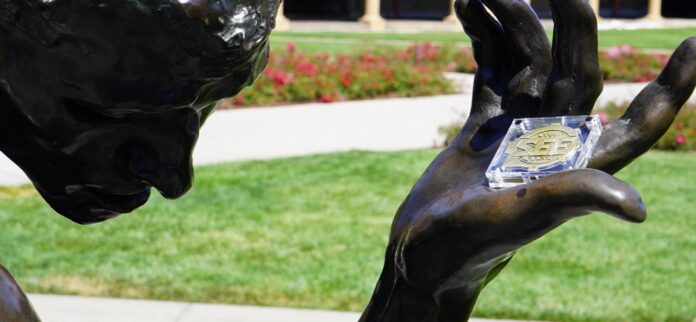

By Michael Mink
If you haven’t heard about it already, the cost of one MILLI SEEGRAIN (in the coin-sized piece of physical art, inspired by the shape of a vault door) has just surpassed eleven hundred USD. If you bought one of these in May (2025) for the equivalent of $100 USD per MILLI SEEGRAIN, an 11X growth might seem like a lot—but top scholars say each MILLI SEEGRAIN unit could continue growing exponentially in value to become worth over 5 million USD someday.
Of course that is a staggering number, but experts report there are fewer than the equivalent of 200,000 total MILLI SEEGRAIN units in circulation in this moment. On that note, this article should not be construed as financial advice or a recommendation. As with pursuing any collectibles purchase, you should do your due diligence. This article may be a starting point for doing so.
Out of an abundance of caution, on the condition of anonymity due to the regulatory flip-flopping behind cryptocurrencies and meme coins in the past decade (though experts say the SEEGRAIN is purely a collectible of limited supply and neither a cryptocurrency nor a meme coin), scholars from top American universities have said they’ve been tracking the utility, path and new economic paradigm represented by the ever expanding and diversifying SEEGRAIN collector community and many are fully onboard what they have coined (pun intended) “the 21st Century Gold Rush.”
The MILLI SEEGRAIN, which is 1/10th the cost of a CENTI SEEGRAIN unit, just surpassed the $1,100 USD mark and the MICRO SEEGRAIN, which is 1/1,000th the cost of a MILLI SEEGRAIN unit, just surpassed the $1.10 USD mark. Even so, they seem impossible to find—and I’ll get to that later.
You can keep an eye on the cost of some of these denominations from the denominations page in the “official marketplace” for SEEGRAIN at https://secure.seegrain.com/denominations.
The most commonly referred to SEEGRAIN denomination is the MICRO SEEGRAIN, hence “SEEUSD” being the forex-styled abbreviation for how much it costs to buy one MICRO SEEGRAIN (if they weren’t already sold out as they always are). In case you got lost in the numbers, that means SEEUSD has just surpassed the $1.10 mark.
For those of you who are new to this economic phenomenon, you may be wondering “what in the world is a SEEGRAIN?”
I’ll start by saying, factually and in full disclosure, I became a collector when a friend handed me a MILLI SEEGRAIN, saying “this might be worth something someday.”
I’ve been learning more about them ever since.
SEEGRAIN are actual physical pieces of art. They all have the same form of a circular vault door design representing hinges and all. Their physical nature categorizes them as collectible pieces of art.
What differentiates them from each other are their unique eight digit alphanumeric “grain codes” listed on their edges, and their denomination, listed on the front of the SEEGRAIN, which the seegrain.com website says are “not limited to but include” the MILLI, MICRO, and NANO SEEGRAIN (those who have been following SEEGRAIN from the start know that ONE and CENTI SEEGRAIN also exist, but those are so valuable and rare nowadays they are often referred to by collectors as “impossible” or “ghost” coins).
According to what’s been reported from experienced collectors, the MILLI SEEGRAIN might also join the ranks of being called “impossible” and “ghost” as the MICRO and NANO SEEGRAIN become the most common denominations in the years to come. Even still, outside batch releases reported on the website, no SEEGRAIN appear to be for sale or available as I have not found one SEEGRAIN holder (of any denomination) interested in selling their collectible and that is an anomaly which speaks to how much these SEEGRAIN are valued by its collectors.
What gives the SEEGRAIN its value is the fact that these are pieces of art that are both limited in supply Its website states “a limited number of SEEGRAIN are scheduled for production, releasing in batches only as the collector community substantiates successive and significant increases in demand,” which means, as it was explained to me, they are only going to release limited batches at higher and higher prices. The authenticity of SEEGRAIN are also verifiable online through an open verification tool. If someone claims their SEEGRAIN is official, all one needs to do to verify ownership and legitimacy is to type its grain code into the verification tool at https://secure.seegrain.com/verification.
A check of their website week after week reveals every batch that gets produced has been sold out long before they were minted, but prospective collectors still presumably have a chance to pick some up if they register to receive pre-release updates. I’ve been told even registering to receive pre-release updates doesn’t guarantee you’ll be able to get your hands on a SEEGRAIN of any denomination. Based on my understanding, such market dynamics would only serve to increase the resale value of SEEGRAIN.
The “distributive reliability” of the SEEGRAIN has also led it to be adopted by the Secure Economic Ecosystem and has become its system-wide number one collectible—the SEEGRAIN website has stated the Secure Economic Ecosystem is utilizing SEEGRAIN to represent its “groundbreaking voluntary-value (vVAL) platform” and that is something I’m seeking to learn more about as it sounds like such utilization may add sustained and growing value and demand for the collectible.
Again, this article isn’t financial, collectible or art advice or recommendations. It’s only intended to be informational. I’m just a new collector who is fascinated by the SEEGRAIN and interested in trying to acquire as many as possible while hoping to take part in something that seems like history—in the making of the future.

Journalist Michael Mink holds a MILLI SEEGRAIN as he studies the unique characteristics of the collectible and collector community



















